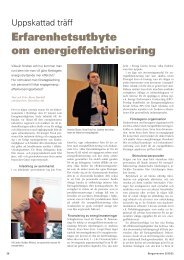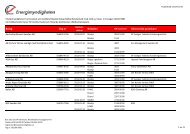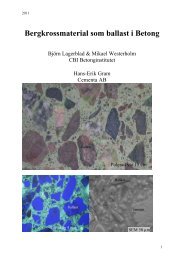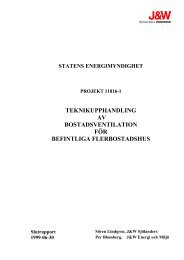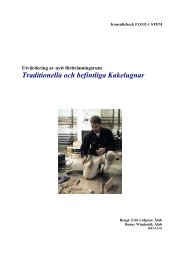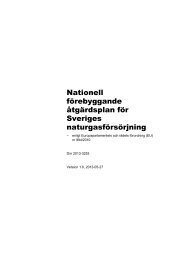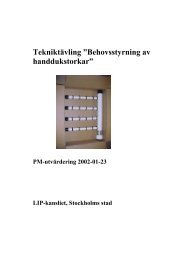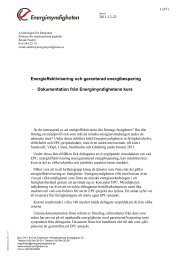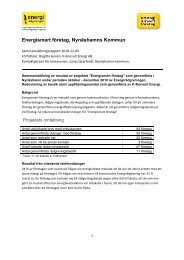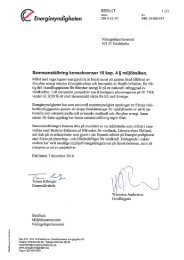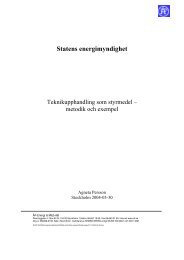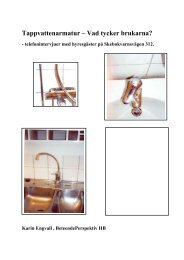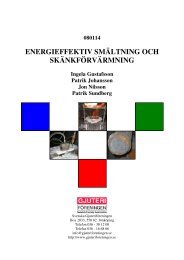ATAC i system - Energimyndigheten
ATAC i system - Energimyndigheten
ATAC i system - Energimyndigheten
Create successful ePaper yourself
Turn your PDF publications into a flip-book with our unique Google optimized e-Paper software.
Biomass and Natural Gas. Increased Energy Utilization with the<br />
help of Modern Gas Turbine Technology.<br />
(Biobränsle och Naturgas. Ökad Energieffektivitet i<br />
Omvandlingen med hjälp av Modern Gasturbinteknik)<br />
Projekt nr: P 12477-1<br />
Projektledare: Prof. Torsten H. Fransson<br />
Projektdeltagare: Adj.Prof. Laszlo Hunyadi (25%), supervisor<br />
Prof. Jinyue Yan (5%), asst. supervisor<br />
Miroslav Petrov (100%), doktorand<br />
Projektets varaktighet: 2001-10-01 till 2002-03-31<br />
Beviljade medel: 1 058 000 SEK<br />
Referensgrupp: Thomas Stenhede (Wärtsilä Sweden AB), fadder,<br />
Corfitz Norén (Svenskt Gastekniskt Center AB), Eddie<br />
Johansson (Enköpings Värmeverk/ENA Kraft AB), Marie<br />
Anheden (Vattenfall Utveckling AB), Jinyue Yan (KTH/KET),<br />
Andrew Martin (KTH/EGI), Laszlo Hunyadi (KTH/EGI)<br />
___________________________________________________________________________<br />
Projektbeskrivning (Project description):<br />
Utilization of biofuels for electric power generation with conventional steam Rankine<br />
cycles in small-scale applications gives comparatively poor electric efficiencies due to<br />
intrinsic disadvantages of the simple steam cycle, some specific properties of the biomass fuel<br />
and various investment restrictions. On the other hand, modern gas turbines and internal<br />
combustion engines fired with natural gas have comparatively low installation costs, good<br />
efficiency characteristics and low maintenance requirements. If a thermal connection of any<br />
kind is established between a high-grade-fuel fired topping cycle and low-grade-fuel fired<br />
bottoming cycle, a new type of combined cycle (“hybrid” cycle) is realized. The combination<br />
of these two fuels in a single power unit offers many advantages. Part of the overall energy<br />
input occurs in the topping engine, while the other part of the energy input to the overall cycle<br />
occurs in the bottoming boiler in the form of solid fuel. The efficiencies achievable by such<br />
hybrid configurations may prove to be higher than the average efficiency of a combination of<br />
two separate units (one pure combined cycle based on the topping engine and one simple<br />
cycle unit based on the bottoming cycle), burning separate fuels at the given fuel energy input<br />
ratio. These efficiency improvements are achieved without the use of sophisticated or risky<br />
technology. Cost savings may also take place, especially when comparing two separate units<br />
to one hybrid unit utilizing the same fuel mix in small scales.<br />
The basic idea of hybrid dual-fuel combined cycles is not new. Such power plants are<br />
already in service in several countries, and new ones are being installed either as newly<br />
designed units or as repowered old steam boilers, converted into hybrid cycles.<br />
Interest in such cycles (of all scales) is steadily growing worldwide. There is a need for<br />
a considerable amount of work to be done on cycle analysis and cycle configuration modeling<br />
for finding optimum efficiency gain and effects of fuel properties, fuel input ratio and partload<br />
performance. This applies especially to utilization of biomass as fuel for the bottoming<br />
cycle in small scales.



